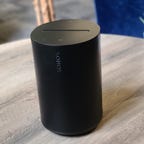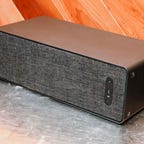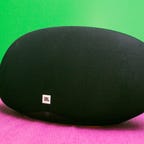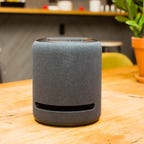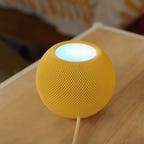Best Wi-Fi Wireless Speaker of 2024
If you've been looking for the best Wi-Fi speakers for streaming music, look no further.
Our Picks
Technology has come a long way. Gone are the days when an amazing entertainment setup would require a ton of wires and expert-level cable management. Instead, you can opt for a more modern and sleek look with one (or several) of the best Wi-Fi wireless speakers around. Wireless speakers can quickly elevate the sound in your space with very little effort. The best Wi-Fi speakers offer a bunch of features that make your life easier. Wi-Fi streaming lets you control music in a multiroom environment, and most Wi-Fi speakers also offer voice control (for instance, Amazon Alexa, Google Assistant or Apple's Siri). That means you can ask your speaker for a specific song, and it'll play it back for you (if you want more on this, don't miss CNET's guide to the best smart speakers).
For the streaming speakers that do offer voice control, if you're not into that you can just turn it off. Either way, you don't need to spend very much -- for instance, a fantastic "dumb" multiroom speaker like the Ikea Symfonisk Bookshelf starts at $140. To help you figure out which will be the perfect fit for your home's audio setup, we made a list of the best Wi-Fi speakers we've tested in the CNET labs. Read on.
Also consider: Best Bluetooth Speakers of 2024
At $249, the Sonos Era 100 is the smart speaker to please any music fan. The compact device makes a few improvements on the award-winning One, including stereo playback and even better sound quality. With Bluetooth, Amazon Alexa and Apple AirPlay 2 compatibility the Era 100 is a more flexible streaming speaker than ever before.
Best budget speaker
Ikea Wi-Fi Symfonisk Bookshelf
For $120 there are excellent smart speakers to choose from, including the Amazon Echo, Nest Audio and HomePod Mini, but the Symfonisk is bigger than all of them. Bigger cabinets usually mean a bigger sound. While this speaker is best as part of a Sonos surround sound system, it also makes a great kids' room or garage speaker.
Best for Android users
JBL Playlist 150
Google may offer a lot of speakers, including the Nest Audio, but the one that was truly great with music -- the Home Max -- has been discontinued. It's surprising then that the list of affordable-yet-good-sounding Chromecast built-in speakers can be counted on the fingers of one hand. Of those, the JBL Playlist is the best I've tested, with a generously sized speaker and enough volume to fill a typical room. It also has Bluetooth and an auxiliary input to expand its flexibility. It may not be "smart", but if you want a system that can be controlled via an existing Google Assistant speaker, this is the one to get.
The best sounding Amazon Echo
Amazon Echo Studio
The Echo Studio comes from the house of Amazon – the creator of Alexa. It is easy to set up and is loud enough to fill a room with sound. With thumping bass, clear sound and good highs, this is easily the best Amazon Echo. You can use Alexa to stream songs from Amazon Music, Apple Music, Spotify, Pandora, Tidal and more.
Best AirPlay speaker
Apple HomePod Mini
The HomePod Mini may be outgunned by the new HomePod in terms of output power, but it is also a third of the price. For its size, the HomePod Mini has a laundry list of useful features -- Siri voice assistant, temperature and humidity controls -- and it sounds really good, too. If you're deep in the Apple ecosystem, especially if you use Siri a lot, then the Apple HomePod Mini should make a seamless addition to your home.
Best portable speaker
Sonos Roam
The Sonos Roam is a portable Bluetooth speaker on steroids -- it can be used out and about or as part of a Sonos multiroom system. It's affordable (for Sonos, that is) and it sounds better than other products of its type. It also comes with a choice of voice assistant to make choosing a song even simpler.
Best for streaming to existing systems
WiiM Pro
Not a speaker as such, but a great option for people who don't want to buy a whole new one. Say you've got a stereo system -- or even an old Bluetooth speaker like the Fluance F170 -- and you want to be able to add Wi-Fi streaming to it. The WiiM Pro offers the best sound and streaming support of any other dongle I can think of -- and it's only $149. The app makes it easy to set up and use, and it will integrate with many multi-room systems too.
We also tested
- JBL Link Portable (Update: Currently Out of Stock) ($180): The Link Portable is a larger-size competitor to the Sonos, being both Wi-Fi and Bluetooth compatible, and it can play louder and with weightier bass. In his review of the Sonos Roam, reviewer David Carnoy says he preferred the sound and build quality of the Sonos and would buy it over the JBL, though the Link Portable is currently $100 off, making it a much more competitive pick.
- Bose Home Speaker 300 (Update: Currently Out of Stock New) ($220): If you're after a responsive smart speaker, the Bose Home Speaker 300 is both snappy in operation and lovely to look at. In terms of audio quality, however, it doesn't measure up to its competitor, the cheaper Sonos One. In addition, the onboard Bose Music multiroom system is not compatible with existing SoundTouch products. The 300 appears to be out of production but it can still be found in new condition at select retailers. Refurbished models are available for even less. Read CNET's review of the Bose Home Speaker 300.
The new HomePod now features an edge-to-edge Siri display
- Apple HomePod (2023) ($300): The new HomePod is a refined take on Apple's first smart speaker with better sound and more features. Despite new-found support for Dolby Atmos, it's the temperature and humidity sensors that are the most palpable changes. Yet, at $300 most people are better off buying the HomePod mini which has an almost identical set of features. Read CNET's review of the Apple HomePod (2024)
- Bowers and Wilkins Formation Flex ($500): A smaller brother to the flashy Formation Wedge, the Flex is still quite stylish and boasts an open-hearted sonic signature. There's plenty of competition at this level, including the Sonos Five, which is capable of a much bigger, party-ready performance. Read CNET's first take on the Formation range.
The Sonos Move
- Sonos Move ($299): If you want a wireless speaker model that's (kinda) portable and water resistant, the Sonos Move offers great sound in a very large box. If you need to power a tailgate or large party this would be great, but for most people, the Sonos Roam is both cheaper and more pocketable. Read CNET's review of the Sonos Move.
- Sony SRS-RA5000 ($798): Where are people supposed to put large speakers like the Sony SRS-RA5000 and the McIntosh RS150? A dressing table -- like, a really big one? The Sony is over a foot tall but adding to its potential awkwardness is its 360-degree playback, making the "best" place to put it at the center of a room. The sound is fine, but if you want to hear 3D audio, the Amazon Echo Studio is a quarter of the price. Read CNET's first take on the Sony SRS-RA5000.
- McIntosh RS150 ($1,200): The massive McIntosh RS150 has some great things going for it -- namely Chromecast built-in, Roon Ready and Spotify Connect. Nonetheless, the sound wasn't as clear as I'd expected and the unit offers no EQ controls to compensate. In addition, while the previous RS100 had the fabled McIntosh blue meter this update misses a trick by replacing it with LEDs. The competitive Naim Mu-so Qb is more compact and offers excellent performance for the same price.
How does CNET test Wi-Fi speakers?
CNET follows a rigorous, unbiased evaluation process for all of our audio testing. We test Wi-Fi speakers ranging from simple bedside speakers all the way through to high-end systems. Our audio lab includes a Roon server running on a Synology NAS, Google Nest and Amazon Echo speakers, plus both iOS and Android devices. Similar speakers are compared side by side in a living room environment with different styles of music and utilizing multiple streaming platforms when required. We grade the sound quality of each by evaluating clarity, dynamics, bass response and stereo imaging (if applicable). If the speaker comes with a proprietary app we will compare that to other competitive controllers.
Wi-Fi Speaker FAQs
Is Bluetooth better than Wi-Fi?
Both of them can be termed as wireless speaker systems. Wi-Fi delivers the same basic convenience as Bluetooth: using your phone's Wi-Fi connection to play music over an external speaker or sound system. Just like speakers that use Bluetooth connectivity, it can work with a subscription music service app such as Spotify (via Spotify Connect) or Apple Music, a radio service like Pandora or TuneIn, or your own music collection. Here are the best reasons to get a streaming Wi-Fi speaker:
- A Wi-Fi speaker sounds better than a Bluetooth speaker due to its higher bandwidth.
- Wi-Fi has a better range.
- Wi-Fi doesn't take over your phone's audio channel -- so you can take a call without interrupting the song, for example.
- It also works great for multiroom audio, allowing playback from multiple speakers all over the house via your Wi-Fi network, all controlled by a single phone app.
How do multiroom speakers work?
Multiroom enables users to play from one or multiple speakers anywhere in the house at once, with most systems able to support up to a dozen or more different zones. If you want to play a song in "house party mode," for example, where it blasts from multiple speakers throughout the house simultaneously, all of those speakers have to share the same ecosystem. For Sonos and other proprietary systems, all of those speakers will have to be Sonos (or connected to a Sonos device). For Chromecast, all of the speakers regardless of brand, will need to be Chromecast-compatible.
How do I connect my Wi-Fi to my music?
Most speakers come with a dedicated companion app for iOS and Android which is used for both setting up and controlling your system. You'll need an internet connection to use a Wi-Fi speaker, and most speakers support at least 2.4GHz connections or even 5GHz. Check your documentation for the name of the app you need and make sure you also have your Wi-Fi password handy. Most apps use a simple step-by-step process, so you should be listening to music in a matter of minutes.






